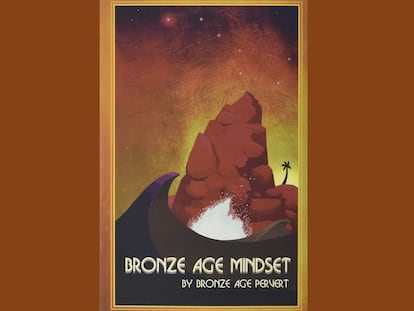Stoicism is back: This is the ‘slave doctrine’ to understand today’s bosses and employees
A philosophical doctrine from 24 centuries ago invites us to accept reality as it is. It offers consolation to the poorest and free rein to the richest… and it has enjoyed renewed success in the form of books, podcasts and hashtags on social media


From Meditations by Marcus Aurelius to the most popular podcasts of 2023, stoicism remains surprisingly relevant. At the moment, it’s one of the most widely disseminated ancient doctrines on the internet and the leading philosophy among the disruptive business elite. From Elon Musk to Bill Gates, from Jack Dorsey to Jeff Bezos, stoicism is embraced. Lifestyle gurus such as Tim Ferriss helped introduce it to Silicon Valley about 10 years ago, creating a suggestive postmodern cocktail consisting of Taoism, Confucianism and Zen meditation.
Some analysts attribute stoicism’s popularity in the first-quarter of this troubled 21st century to the fact that it’s a practical philosophy… a “school of life,” in Ferriss’ own words. But, back in 2016, journalist Olivia Goldhill wondered — in a lucid article in Quartz — what Gates and company could be learning from an ancient doctrine that was “conceived by Greek slaves,” which preaches that success is an illusion and that austerity must be cultivated.
Sandy Grant — a philosopher at the University of Cambridge — describes stoicism as an intellectual movement that set out to “bring comfort to the oppressed” in a world “of slaves and rigid hierarchies,” in which women were considered “property” of their men: fathers, brothers, or husbands. Even popular philosophers, such as Ryan Holiday — author of the bestselling The Daily Stoic: 366 Meditations on Wisdom, Perseverance, and the Art of Living — find it paradoxical that modern stoics seem to proliferate, above all, at the top of the social pyramid, rather than at its base.
Our everyday stoicism
What’s so stoic about Elon Musk? Well, according to one of the official newsletters of contemporary neostoicism — The Daily Stoic, Holiday’s blog — his business merits demonstrate this. However, the blog reproaches him for a lack of verbal restraint that would have exasperated the Emperor Marcus Aurelius.

Musk — in the opinion of his coreligionists-turned-detractors — has “too many opinions” to be in line with stoicism. He’s too prone to “embark on petty feuds, disrespect his employees with disabilities, spread disinformation and propaganda, attack journalists” and, in general, “get swept up in contemporary culture wars.” None of these attitudes seems very compatible with the serenity, virtue, balance and inner silence that the doctrine of Stoicism promoted more than 2,000 years ago.
What’s more, with the acquisition of Twitter (now X), Musk has become a direct promoter of a culture of instantaneousness and noise, which is completely incompatible with that school of thought. Even if he were to read the works of the three most important Stoic philosophers — Marcus Aurelius, Seneca and Epictetus — or impose superficial exercises to harden the spirit (such as sleeping on the floor of his factories), The Daily Stoic considers this way of life to be something entirely different.
That being said, Oscar Lagrosen — a blogger on Medium — accepts the thesis that Elon Musk would be “the modern Seneca.” His arguments? Both the philosopher from Córdoba, Spain and the entrepreneur — born in Pretoria, during the apartheid era in South Africa — were the richest men of their times: the $222 billion that Musk possesses would be the approximate equivalent of the formidable 300 million sesterces that Seneca accumulated. Furthermore, according to Lagrosen, both amassed their fortunes by practicing virtue — “without a hint of corruption” —, had the discipline necessary to make the most of their respective talents and did “good” without expecting retribution or recognition. Lagrosen claims that Musk undertook an altruistic feat that was highly-publicized but has been questioned by experts: he allegedly donated a substantial part of his fortune to charity… although it’s not entirely clear when he did this and where the money went.

Of course, behind such disparate assessments lie divergent ways of understanding stoicism. For academics — such as Sandy Grant, John Sellars, or Víctor Gómez Pin — this ancestral wisdom must be contextualized, interpreted and (when appropriate) applied, taking into account its complexity and nuances. For popularizers with or without a philosophical pedigree — such as Lagrosen or Massimo Pigliucci — it would be enough, perhaps, to rummage through the attic of the old doctrine, identify some ideas with a hint of validity and add a discreet veneer of “self-help” rhetoric to them. Hence the proliferation of podcasts that provide “stoic recipes” to enjoy (or cope with) everyday life, but often ignore or omit the fundamental question: what did Stoicism — the actual doctrine — truly consist of?
Stoicism is a philosophical school founded by the Cypriot wise man Zeno of Citium, in Athens, at the beginning of the 3rd century BC. This was in the middle of the Hellenistic period. The Stoics met under an Athenian portico — the stóa — and there, they developed a personal ethic based on the pursuit of happiness and virtue through rational behavior, self-control and tolerance. These ideas took very solid roots in imperial Rome in later centuries, ultimately becoming the hegemonic intellectual and spiritual current, spreading across all levels of society.
Gates, Bezos and company may know the story… but this doesn’t seem to be the aspect that most interests them. They limit themselves to buying — with somewhat uncritical enthusiasm — the stoicism of Tim Ferriss, which he defines as “a simple and immensely practical set of rules for better results with less effort.”
Stoicism — as Ferriss understands it — would be a sophisticated variant of mindfulness, combined with the exaltation of business leadership and the culture of effort. Other recent popularizers have made an effort — despite everything — to strip it of that elitist veneer and promote a stoic doctrine of popular orientation, suitable for all audiences. This is the case of The Little Book of Stoicism: Timeless Wisdom to Gain Resilience, Confidence, and Calmness, by Jonas Salzbeger.
Other examples of bite-sized Hellenistic wisdom are easily within reach via Way of the Stoic, by Ollie Snider, or Holiday’s The Daily Stoic. These are philosophical guides regarding how to be more tenacious, calm and resilient. In almost all of these essays — which are more or less close to the self-help genre — the concept of “resilience” is key, a quality that’s very fashionable today. By consuming stoicism in judicious homeopathic doses, you will become increasingly resilient. But is the “recipe” really so simple?
In a conversation with EL PAÍS, Spanish philosopher Víctor Gómez Pin recommends “dispelling the confusion” by turning to sources. That is, accessing the original Stoicism (and the rigorous interpretations made by experts), instead of settling for “interested, vulgar and trivial” substitutes… the “small s” stoicism.

David Hernández de la Fuente — a writer and professor of classical philology at the Complutense University of Madrid — has been in charge of the translation, introduction and notes for a revised edition of Meditations, by Marcus Aurelius. He describes the work as “the intellectual memoirs of a model ruler,” as well as a book “that was not conceived for us to read, but rather as the vehicle that this cultured man — who had a contemplative attitude — found to question himself. [It’s as if] he had two voices coexisting [in his head]: one that doubted and suffered, while the other acted as a teacher, offering comfort and certainties.”
In light of this “fascinating” text, Hernández notes, we would have to conclude that Musk, Gates and the others of their ilk aren’t very stoic-like at all. “Maybe they have a soft veneer [of stoicism]. Although it’s possible that their interest in that intellectual trend, which is quite popular — throwaway stoicism — has given them a certain tranquillity. In general, though, these newly-minted stoic entrepreneurs often say that [the doctrine has] taught them temperance and self-control… and I don’t doubt it. But, judging by their actions, they are driven by business interests that are far removed from stoicism. I think what interests them most about Marcus Aurelius is that he was the most powerful man of his time and that he oversaw an empire.”
Build it and they will come
Hernández — despite his qualms — still feels that the attempts to disseminate stoicism are “legitimate.” They bring the school of thought back to our time, even if this occurs in a “vulgar” fashion. “After all,” he shrugs, “philosophy has always been vulgarized to adapt it to all types of audiences. Ultimately, it doesn’t matter too much if you come into contact with stoicism through an informative book, a podcast, a website, a television program, or a tweet. If it captures your interest, you will take it upon yourself to delve deeper into it and you will end up exploring — at your own pace — a very ancient doctrine that continues to offer crucial lessons for the present.”
The philosopher is more concerned that this wealth of wisdom is accessed “through unrigorous and hastily-completed translations,” or, worse, via “[biased] reinterpretations.” But he thinks that, even so, the curious and attentive reader will end up finding their way to “treasures,” such as “the reflections of Epictetus, the fragments of Zeno, the complex and very fertile thought of Seneca.” They may even encounter Meditations, “a masterpiece of introspection and a hymn to the intimate dignity of the human being.”
Can you really be stoic in 2023? Is it worth trying? Hernández recalls that “the globalized universe in which Stoicism emerged — that of Hellenistic Greece and the Roman Empire — was similar to ours in its high degree of interconnections, its political turbulence, or the climatic, health and environmental challenges it faced.” But it was also a very different world, “in which not even the highest spirits — like Marcus Aurelius — questioned slavery, the submission of women, or the validity of violent imperialism.”
The cultural distance that separates that time from our own is immense. Hernández feels that “any attempt at a naive and uncritical application of stoicism would be absurd and counterproductive.” On the other hand, he emphasizes that there are some “universal elements of stoic wisdom” that continue to be valid. To him, the philosophy seems “useful for moments of crisis, because it’s an ethic of duty, serenity and responsibility, which invites us to practice self-care and care of others. This has a social aspect, because it invites us to collaborate, to act in an empathetic, understanding and tolerant manner.”
The virtuous life
The philosopher, essayist and teacher Eduardo Infante — the author of several essays on Hellenistic philosophy — takes a more critical approach. He feels that the original Stoics “shouldn’t be confused with the topical image that early Christianity spread about them.” They were by no means “masochists who pursued redemption through pain.” On the contrary, “they strove to avoid it by rationalizing it, relativizing it and distancing themselves from it.” They practiced self-analysis as a tool to become “excellent people.” That is, “balanced, sensible and fair,” capable of distancing themselves “from anguish, restlessness and the compulsive search for immediate satisfaction of desire, which is the true source of unhappiness and suffering.”
Stoicism — as described by Hernández de la Fuente — was, in its day, “an intellectual revolution” that taught the inhabitants of a turbulent world “to live better, in a more virtuous and rational way.” It coexisted with Greco-Roman polytheism, mystery cults and Christianity. It was part of the dominant ideology and had a profound impact on everyday life. But it was never an exclusive cult or a dogmatic religion. No one was required to “convert” to Stoicism… but it was often useful to know and practice it.
Hernández declares himself to be a fervent believer in “philosophy as salvation” and an occasional supporter of “vulgar stoicism” in everyday use… so long as it doesn’t “preach radical indifference to pain, be it one’s own and that of others.” Rather, he prefers that it teach people how to confront pain in an ethical framework “of good living, of a life that is both active and contemplative, in accordance with the logic of nature.”
Two practical pieces of advice from ancient Stoicism seem especially valid today: “Face reality as it is, turning off bad judgments and false perceptions. Cultivate your mind with the same discipline with which the athlete cultivates his body,” Hernández affirms. Still, he warns about its main deficiency: the school of thought advocates for a certain conformism, since “it’s based on the need to accept reality as it is” and find — within that acceptance — an intimate guide to conducting yourself in society. “Stoicism,” Hernández concludes, “isn’t a useful philosophy for those who want to change the world.” Perhaps this is one of the less obvious (and more disturbing) reasons for the persistent popularity of this school of thought among the elites, no matter how disruptive they may purport to be.
Sign up for our weekly newsletter to get more English-language news coverage from EL PAÍS USA Edition
Tu suscripción se está usando en otro dispositivo
¿Quieres añadir otro usuario a tu suscripción?
Si continúas leyendo en este dispositivo, no se podrá leer en el otro.
FlechaTu suscripción se está usando en otro dispositivo y solo puedes acceder a EL PAÍS desde un dispositivo a la vez.
Si quieres compartir tu cuenta, cambia tu suscripción a la modalidad Premium, así podrás añadir otro usuario. Cada uno accederá con su propia cuenta de email, lo que os permitirá personalizar vuestra experiencia en EL PAÍS.
¿Tienes una suscripción de empresa? Accede aquí para contratar más cuentas.
En el caso de no saber quién está usando tu cuenta, te recomendamos cambiar tu contraseña aquí.
Si decides continuar compartiendo tu cuenta, este mensaje se mostrará en tu dispositivo y en el de la otra persona que está usando tu cuenta de forma indefinida, afectando a tu experiencia de lectura. Puedes consultar aquí los términos y condiciones de la suscripción digital.
More information
Archived In
Últimas noticias
Most viewed
- Reinhard Genzel, Nobel laureate in physics: ‘One-minute videos will never give you the truth’
- Oona Chaplin: ‘I told James Cameron that I was living in a treehouse and starting a permaculture project with a friend’
- Pablo Escobar’s hippos: A serious environmental problem, 40 years on
- Why we lost the habit of sleeping in two segments and how that changed our sense of time
- Chevy Chase, the beloved comedian who was a monster off camera: ‘Not everyone hated him, just the people who’ve worked with him’










































